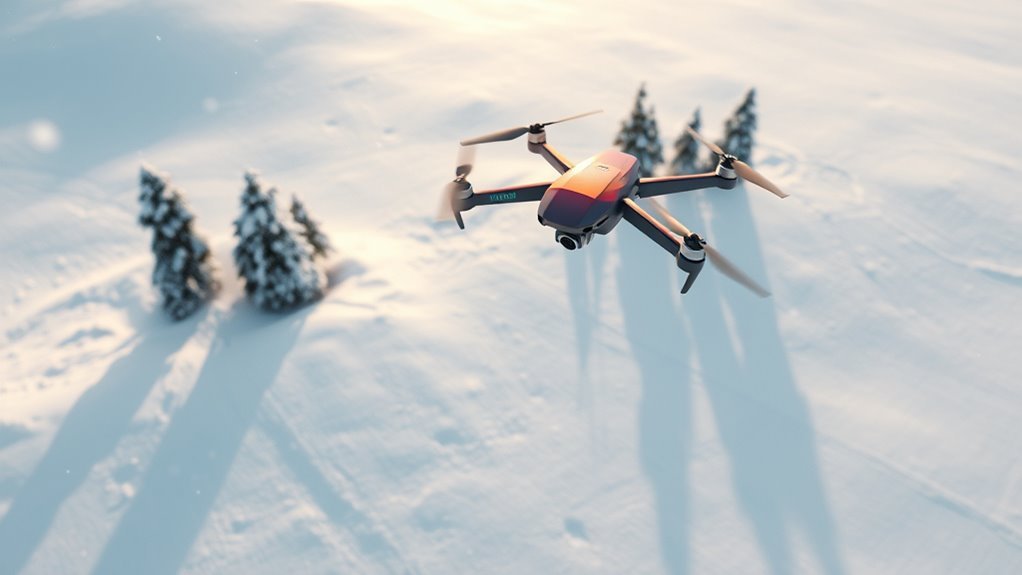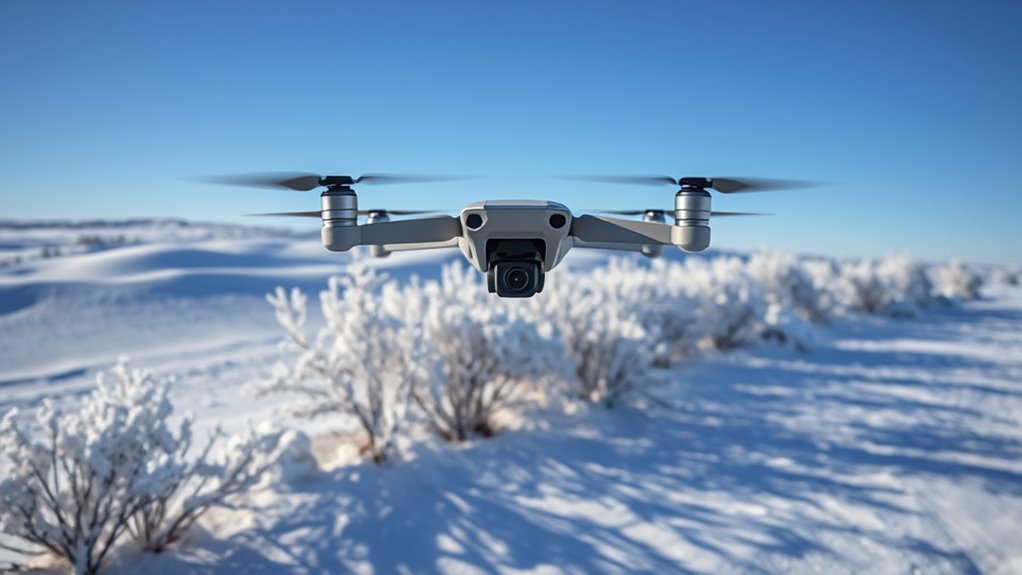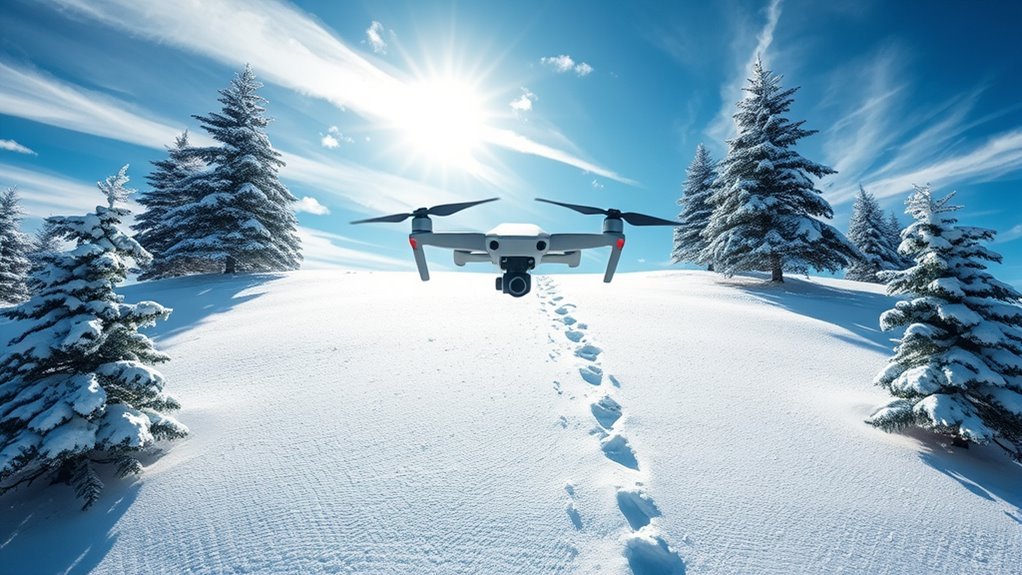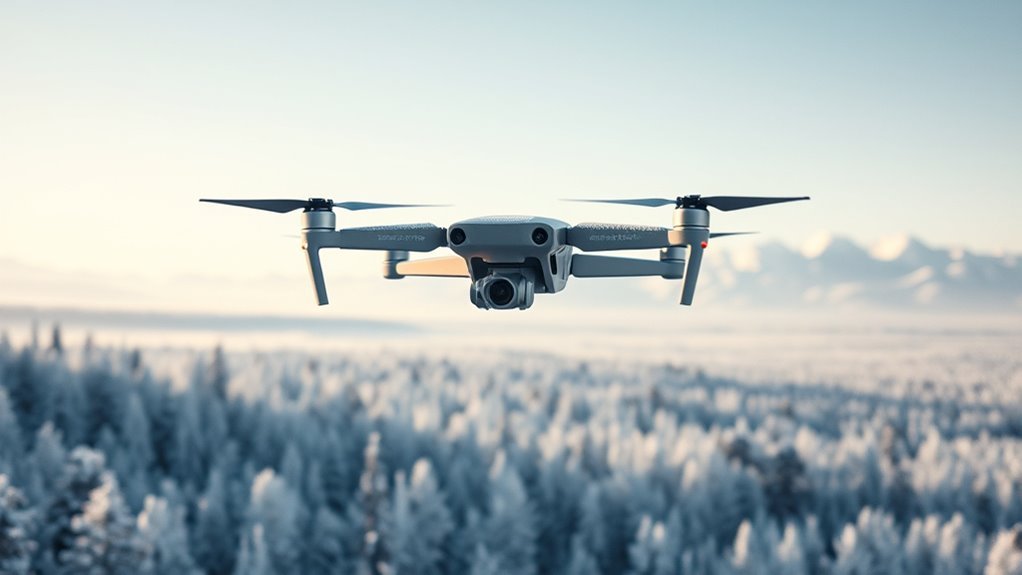To fly a drone in snow, you need to understand how cold weather impacts battery life, so keep your batteries warm and insulated. Make sure your drone is prepared by checking insulation and adding propeller guards to prevent snow buildup. Visibility is essential, so choose contrasting colors for your drone and maintain line-of-sight. Finally, dress warmly and keep extra batteries handy. There’s more to take into account for safe and effective winter flights, so let’s explore further.
Understanding Battery Performance in Cold Weather

Although flying a drone in snowy conditions can be exhilarating, understanding how cold weather affects battery performance is essential for a successful flight. In colder temperatures, battery chemistry undergoes significant changes, leading to reduced capacity and efficiency. Lithium polymer batteries, commonly used in drones, are particularly sensitive to temperature effects. As the temperature drops, the chemical reactions within the battery slow, resulting in less energy available for your flight. You might notice shorter flight times or a drop in power. To mitigate these issues, consider pre-warming your batteries before use and keeping them insulated during flight. Monitoring your battery’s voltage and performance closely will help you maintain peak control and enjoy the freedom of flying, even in winter’s chill.
Preparing Your Drone for Snowy Conditions

Before you take to the skies in snowy conditions, it’s crucial to prepare your drone to guarantee peak performance and safety. Start by checking the drone insulation; consider using thermal wraps to maintain ideal battery temperature. Cold air can sap battery life quickly, so make sure everything’s snug and warm. Next, focus on propeller protection; install guards or covers to prevent snow accumulation and ice formation. This’ll help maintain your drone’s stability and responsiveness during flight. Additionally, inspect all components for moisture and wipe them down to prevent damage. By taking these steps, you’ll not only enhance your drone’s performance but also guarantee a more enjoyable flying experience in the winter wonderland. So gear up, and enjoy the freedom of flying in the snow!
Ensuring Visibility While Flying

How can you guarantee your drone stays visible against a snowy backdrop? First, invest in high-quality drone lighting. Bright LED lights can enhance visibility, especially in low-light conditions or during overcast weather. Choose colors that contrast sharply with the snow, like red or green. Next, plan your flight path strategically. Stay within a reasonable distance and maintain line-of-sight to track the drone easily. Avoid flying too high, as this can make it harder to see against the bright white snow. Additionally, consider using a drone with a built-in GPS or altitude indicator, which helps you remain oriented. By combining effective drone lighting with careful flight path planning, you’ll make certain your drone remains visible and you enjoy the freedom of flying safely.
Tips for Capturing Stunning Winter Imagery
When you’re ready to capture stunning winter imagery with your drone, it’s essential to reflect on the unique challenges posed by the snowy landscape. Start by taking advantage of winter light; the low sun creates dramatic shadows and enhances colors. Aim to fly during golden hours—early morning or late afternoon—for the best results.
Consider the snow reflections; they can add depth and contrast to your shots. Use polarized filters to reduce glare and enhance the clarity of your images.
Adjust your camera settings to compensate for the bright snow, ensuring you don’t overexpose your shots. Finally, experiment with angles and heights to find unique perspectives, allowing the beauty of winter to unfold beneath your drone’s lens.
Managing Snow Accumulation on Your Drone
As you navigate the snowy skies, managing snow accumulation on your drone becomes crucial to maintaining its performance and capturing quality footage. Regular drone cleaning is important; after each flight, inspect your drone for any snow buildup. Gently brush away snow using a soft, dry cloth to avoid scratching surfaces. Pay special attention to the propellers and camera lens, as snow can impair functionality and image quality. If you notice ice forming, use a small amount of warm water to help with snow removal, but avoid submerging any parts. Always make certain your drone is completely dry before the next flight. By keeping your drone snow-free, you’ll enjoy smoother operation and stunning visuals in winter’s embrace.
Adjusting Flight Settings for Winter Operations
After confirming your drone is free from snow accumulation, it’s time to adjust your flight settings for winter operations. Start with flight mode adjustments; consider switching to a more stable mode, like altitude hold, to combat wind gusts and maintain control. Next, tweak your sensitivity settings; lower them slightly to prevent overly responsive controls that can lead to abrupt movements in icy conditions. This will help you achieve smoother maneuvers while flying. Additionally, check your GPS settings to guarantee maximum accuracy, as satellite signals may be weaker in snowy environments. By fine-tuning these settings, you’ll enhance your drone’s performance and enjoy a more liberated flying experience in winter landscapes.
Safety Precautions for Cold Weather Flying
Although flying a drone in cold weather can be exhilarating, it’s crucial to prioritize safety to avoid mishaps. First, make sure you’re dressed appropriately in cold weather gear to maintain comfort and dexterity while flying. Layer up and wear gloves that allow for control without sacrificing warmth. Next, check your drone’s battery life; cold temperatures can reduce performance considerably, so carry extra batteries and keep them warm in your pockets. Before you take off, verify that your drone insurance covers cold-weather incidents. This precaution protects your investment in case of accidents. Finally, always keep your drone within visual line of sight and be aware of your surroundings. By following these safety precautions, you can enjoy your winter flights with peace of mind.
Post-Flight Care and Maintenance in Snowy Conditions
Once you land your drone in snowy conditions, it’s essential to perform thorough post-flight care to guarantee its longevity and maximum performance. Start with drone cleaning, making sure you remove any snow or moisture from the body and components. Pay special attention to the propeller care; snow can accumulate and affect performance.
Here’s a simple checklist for your post-flight care:
| Task | Purpose | Frequency |
|---|---|---|
| Clean the drone | Prevent corrosion and damage | After each flight |
| Inspect propellers | Guarantee safe operation | After each flight |
| Dry battery contacts | Prevent short circuits | After each flight |
Following these steps will keep your drone in peak condition, ready for your next snowy adventure!
Frequently Asked Questions
Can I Fly My Drone During a Snowstorm?
While it might seem tempting to dance through a snowstorm with your drone, think twice. Snow visibility can hinder your flight, and drone safety should always come first. Stay grounded until conditions improve for a safer experience.
What Are the Best Drones for Winter Flying?
When considering the best drones for winter flying, look for drone specifications like temperature resistance and waterproofing. Models with winter features, such as enhanced battery performance and stability, guarantee you can capture stunning winter landscapes confidently.
How Cold Is Too Cold for Drone Flight?
When it’s too cold, you’ll feel the chill in your drone’s battery performance. Generally, anything below 32°F affects temperature effects on flight; consider a warmer day for peak performance and extended battery life.
Will Snow Damage My Drone’s Camera?
Snow can damage your drone’s camera if moisture gets inside. To prevent this, guarantee proper camera protection and effective moisture management. Using lens covers and sealing openings helps keep your equipment safe while you explore winter skies.
Can I Use My Drone in High Winds During Winter?
You shouldn’t fly your drone in high winds during winter. Wind resistance can severely impact flight stability, making control difficult. Always check wind conditions, and prioritize safety over the thrill of capturing stunning winter landscapes.

